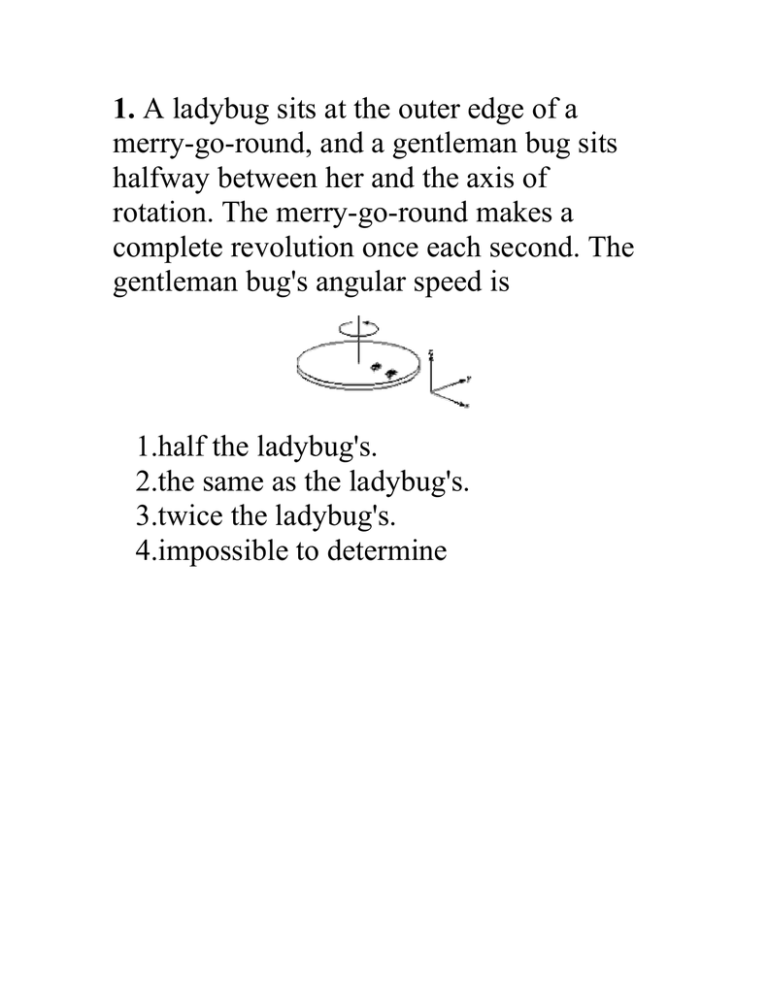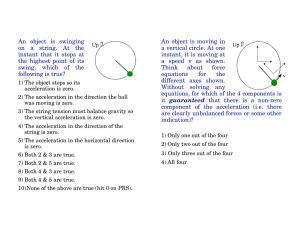1. merry-go-round, and a gentleman bug sits rotation. The merry-go-round makes a
advertisement

1. A ladybug sits at the outer edge of a merry-go-round, and a gentleman bug sits halfway between her and the axis of rotation. The merry-go-round makes a complete revolution once each second. The gentleman bug's angular speed is 1.half the ladybug's. 2.the same as the ladybug's. 3.twice the ladybug's. 4.impossible to determine 2. A ladybug sits at the outer edge of a merry-go-round, that is turning and slowing down. At the instant shown in the figure, the radial component of the ladybug's (Cartesian) acceleration is 1.in the +x direction. 2.in the -x direction. 3.in the +y direction. 4.in the -y direction. 5.in the +z direction. 6.in the -z direction. 7.zero. 3. A ladybug sits at the outer edge of a merry-go-round that is turning and slowing down. The tangential component of the ladybug's (Cartesian) acceleration is 1.in the +x direction. 2.in the -x direction. 3.in the +y direction. 4.in the -y direction. 5.in the +z direction. 6.in the -z direction. 7.zero. 4. Consider two people on opposite sides of a rotating merry-go-round. One of them throws a ball toward the other. In which frame of reference is the path of the ball straight when viewed from above: (a) the frame of the merry-go-round or (b) that of Earth? 1.(a) only 2.(a) and (b)-although the paths appear to curve 3.(b) only 4.neither; because it's thrown while in circular motion, the ball travels along a curved path. 5. The ""barrel of fun"" must spin at a certain minimum angular speed in order for a rider of mass m1 to stick to the wall. Does this minimum angular speed change for a rider of mass m2>m1? 1.yes 2.no 3.3. Not enough information to determine. 6. An object moves counter-clockwise along the circular path shown below. As it moves along the path its acceleration vector continuously points toward point S. The object 1.speeds up at P, Q, and R. 2.slows down at P, Q, and R. 3.speeds up at P and slows down at R. 4.slows down at P and speeds up at R. 5.speeds up at Q. 6.slows down at Q. 7.No object can execute such a motion. 7. As the object speeds up along the circular path shown below, its acceleration points: 1.toward the center of the circular path. 2.in a direction tangential to the circular path. 3.outward. 4.none of the above. 8. You are a passenger in a racecar approaching a turn after a straight-away. As the car turns left on the circular arc at constant speed, you are pressed against the car door. Which of the following is true during the turn (assume the car doesn't slip on the roadway)? 1.A centripetal force pushes you against the door. 2.There is no force that pushes you against the door. 3.The frictional force of the ground pushes you against the door. 4.There is no centripetal force acting on you. 5.You cannot analyze this situation in terms of the forces on you since you are accelerating. 6.Two of the above. 7.None of the above. 9. Which of the following types of forces can produce a centripetal acceleration ? 1.Normal force 2.Frictional force 3.Tension force 4.Gravitational force 5.All of the above 10. A truck, with a ball free to roll around in the bed, takes a turn to the right. Which of the following forces causes the ball to roll to the left side of the truck? 1.frictional force 2.centrifugal force 3.attraction to the truck bed 4.""g"" force 5.no force 11. A car was found off the side of the road. When the police come to investigate, they notice objects in the back of the car are piled up against the passenger-side wall. What can they conclude about what happened to the car? 1.It spun off the road clockwise as viewed from above. 2.It spun off the road counterclockwise as viewed from above. 3.It didn't spin as it went off the road. 12. A ball is suspended from a vertical rod by two strings of equal strength and equal length. The strings are very light and do not stretch. The rod is spun with a constant angular acceleration. Which string breaks first? 1.the upper string 2.the lower string 3.they break simultaneously 4.cannot tell without more information 13. A small ice cube slides in a bowl with negligible friction. You release the ice cube from rest near the top edge of the bowl. At the bottom of the bowl the acceleration is 1.zero. 2.directed horizontally. 3.directed vertically. 4.none of the above. 14. A stone attached to a string is whirled in a vertical plane. Let T1, T2, T3, and T4 be the tensions at locations 1, 2, 3, and 4 required for the stone to have a given speed v0 at these four locations. 1.T3 > T2 >T1 = T4 2.T1 = T2 = T3 = T4 3.T1 > T2 = T4 > T3 4.none of the above 15. A puck of inertia M is moving in a circle at uniform speed on a frictionless table as shown above. It is held by a string which holds a suspended bob, also of inertia M, at rest below the table. Half of the length of the string is above the tabletop and half below. What is the centripetal acceleration of the moving puck? 1.less than g 2.g 3.greater than g 4.zero 5.insufficient information 16. A puck of inertia M is moving in a circle at uniform speed on a frictionless table as shown above. It is held by a string which holds a suspended bob, also of inertia M, at rest below the table. Half of the length of the string is above the tabletop and half below. Now, the hanging bob is pulled down such that the hanging portion of the string is longer than the portion above the tabletop (without changing the total length of the string), but the hanging bob is still at rest. What is the centripetal acceleration of the moving puck now? 1.less than g 2.g 3.greater than g 4.zero 5.insufficient information 17. A ball tied to a string is swung in a vertical circle at constant speed. At what point on the circle is the tension in the string greatest? 1.top 2.bottom 3.the tension is the same everywhere 4.insufficient information to answer this question 18. A bicycle tire rolls across the ground as shown below. If the center of mass of the tire moves (to the left) with speed v, what is the speed of point C at the instant shown? 1.v 2.v/2 3.2v 4.0 5.depends on radius of tire 19. A bicycle tire rolls across the ground. Which of the four marked points on the tire is moving fastest? 1.a 2.b 3.c 4.d 20. A bicycle tire rolls across the ground as shown below. What point on the tire is moving straight down? 1.a 2.b 3.c 4.d 5.all of the above 6.none of the above 21. Consider a cube lying on a rotating turntable. The free-body diagram for the cube in the position show at left is given by the diagram at right. 1.Because of its inertia. 2.Becuase of its rotational inertia. 3.Because of friction. 4.Because of some other reason. 5.It does fly toward the center!



